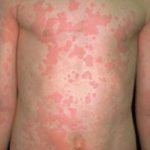 A vascular reaction of the skin that presents with pale red, raised, and itchy bumps. Commonly referred to as hives and may be associated with the sensation of burning or stinging. It often occurs in response to an allergic reaction but it can be induced by nonallergic conditions. Allergicinduced reactions usually last less than 6 weeks and are called acute urticaria. Nonallergic reactions usually last longer than 6 weeks and are called chronic urticaria.
A vascular reaction of the skin that presents with pale red, raised, and itchy bumps. Commonly referred to as hives and may be associated with the sensation of burning or stinging. It often occurs in response to an allergic reaction but it can be induced by nonallergic conditions. Allergicinduced reactions usually last less than 6 weeks and are called acute urticaria. Nonallergic reactions usually last longer than 6 weeks and are called chronic urticaria.
(Or hives) is a skin condition, commonly caused by an allergic reaction, that is characterized by raised red skin welts.
An itchy rash which results from inflammation and leakage of fluid from the blood into the superficial layers of the skin in response to various mediators. Synonyms are ‘hives’ or ‘nettle rash’.
An allergic disorder marked by raised patches of skin causing itchy swellings of the skin.
Vascular reaction of the skin characterized by the temporary eruption of wheals; hives.
An allergic condition characterized by itching wheals.
An allergic reaction to injections, particular foods or plants where the skin forms irritating reddish patches.
A vascular reaction of the skin characterized by severe itching and rash.
Itchy skin eruption characterized by well-defined, red-margined, pale-centered transient wheals; It is usually the result of an allergic reaction to drugs, food, or insect bites, but in some cases, especially chronic ones, the cause cannot be identified. Treatment is by avoidance of the offending agent, and, when an eruption occurs, antihistamines; also called hives.
Hives marked by redness and swelling wheals.
An acute or chronic allergic reaction in which red round wheals develop on the skin, ranging in size from small spots to several inches across. These itch intensely and may last for hours or days; the cause is sensitivity to certain foods, such as shellfish or strawberries. Sometimes urticaria may affect areas other than the skin, causing swelling on the tongue and lips: this serious variety, angioneurotic edema, needs urgent medical attention.
The rash produced by the sudden release of histamine in the skin. It is characterized by acute itching, redness and weals which subsides within a few minutes or may persist for a day or more. Depending upon the cause, it may be localized or widespread, and transient or constantly recurrent over years. It has many causes.
An allergic reaction marked by multiple discrete swellings on the skin (wheals) that are intensely itchy and last up to 24 hr. The wheals appear primarily on the chest, back, extremities, face, or scalp.
A dermatological condition, alternatively referred to as urticaria or hives, characterized by the emergence of itchy welts, typically found on the limbs and torso. These welts can sometimes combine to create uneven, elevated patches.
Urticaria is usually benign and tends to endure for a short span of hours, although there are instances where a chronic or recurring variant emerges. This condition can at times be accompanied by angioedema, which involves allergic swelling affecting different body regions. Dermographism constitutes a less frequent manifestation of urticaria, wherein welts develop upon stroking the skin.
The root cause is frequently unidentified. The predominant recognized trigger is often an allergic response, frequently linked to a particular food or medication. Urticaria can also develop after encountering factors like high temperatures, cold, or sunlight. In rarer instances, it might be connected to another medical condition such as vasculitis, systemic lupus erythematosus, or cancer.
To alleviate itching, one can apply calamine lotion or utilize antihistamine medications. In more serious instances of urticaria, corticosteroid drugs might be necessary. Recognizing and steering clear of potential triggers can aid in averting subsequent reactions. A predisposition to urticaria frequently fades over time even without intervention.
Urticaria, also known as hives or nettle rash, is a skin condition characterized by intensely itching wheals that have elevated, usually white centers and are surrounded by red skin (erythema). These wheals tend to appear in clusters all over the body, typically disappearing within a day or two, and are generally not associated with systemic disturbances. Urticaria is often triggered by allergic reactions, such as contact with irritants like nettles, insect bites, jellyfish stings, or substances like flannel, recently dyed clothing, or cheap furs. Certain foods like shellfish, tinned fish, pork, pickles, mushrooms, and strawberries, as well as medications like penicillin, quinine, aspirin, and sulfa drugs, can also induce urticaria. Intestinal worm infestations or nervous and psychological factors may contribute to its occurrence. Relief can be obtained through topical applications like calamine lotion or antihistamine creams, or through oral medications like ephedrine tablets or antihistamine drugs. Recurrent episodes require a comprehensive investigation into the individual’s nervous system and lifestyle to identify the underlying trigger.
